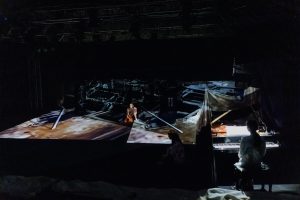©Christine Miess
by Alix Eynaudi & guests
premiere at brut Wien November 2024
article in Der Standart
article Lodie Kardouss in pzazz
article Jasper Delva in e-tcetera
if dance was the pretext, the preface of inscriptions-traces, grammatically possessed, a potential to signify “nothing, in particular”? Death by Landscape, a concert is a hosting of works by artists Han-Gyeol Lie & Paul Kotal (turf + surf), costume designer An Breugelmans, film maker Ujjwal Kanishka Utkarsh, visual artist Cécile Tonizzo, light designer Yasemin Duru and dance artists Hugo Le Brigand & Alix Eynaudi. Juxtaposing their works in the undergrowth of a dark theater room, together they co-produce an atmosphere, an atmosphere that allows things not to snap into making sense.
Death by Landscape, a concert, oscillates between a second night’s encounter, an hommage to Janet, a cadence out of time, une balade dans le bois, a melody sung in darkness, a sting removed by fiction, a waste of time, an act of archeography, a thank-you-dance, a dance to under-grow. Falling through the fields, thanks and at the cost of semantic fields, fields of vision, fields of studies, wheat fields, oil fields, magnetic field, agricultural field, agricultural field labor, battlefields, Death by Landscape, a concert leaves an iridescent trail of mourning lotion in the room that opens gaps in the sound, inserts air and dances there: i want to publish words in your knee, under your left patella. The music, organised in a three-parts composition for electro-acoustically prepared piano and modified pressure-chamber speakers, plays under the title Mother Goose – an homage to Maurice Ravel’s eponymous piece as well as to the popular computer game from the 1980s. “There are no backgrounds in any of these [tableaux], no vistas; only a great deal of foreground that goes back and back, endlessly, involving you in its twists and turns of curtains and films.” almost writes Margaret Atwood. Heart drops, an acceleration of a breath: there is a piano tune between the palm of my hand and the floor.
**************
In the old, scratched, cheap wood of the typing stand there is a landscape, veined, which only a child can see or the child’s older self, a poet, a woman dreaming when she should be typing the last report of the day. If this were a map, she thinks, a map laid down to memorize because she might be walking it, it shows ridge upon ridge fading into hazed desert here and there a sign of aquifers and one possible watering-hole. If this were a map it would be the map of the last age of her life, not a map of choices but a map of variations on the one great choice. It would be the map by which she could see the end of touristic choices, of distances blued and purpled by romance, by which she would recognize that poetry isn’t revolution but a way of knowing why it must come. If this cheap, mass produced wooden stand from the Brooklyn Union Gas Co.. mass-produced yet durable, being here now, is what it is yet a dream-map so obdurate, so plain, she thinks, the material and the dream can join and that is the poem and that is the late report.
– Adrienne Rich, Dreamwood, 1987
Happy are the solitary ones
Those who sow the sky in avid sand
Those who seek the living under the skirts of the wind Those who run panting after an evaporated dream For they are the salt of the earth
Happy are the lookouts over the ocean of the desert Those who pursue the fennec beyond the mirage
The winged sun loses its feathers on the horizon
The eternal summer laughs at the wet grave
– Joyce Mansour, Blue Like a Desert, around 1960
She looks at the paintings, she looks into them. Every one of them is a picture of Lucy. You can’t see her exactly, but she’s there, in behind the pink stone island or the one behind that. In the picture of the cliff, she is hidden by the clutch of fallen rocks toward the bottom; in the one of the river shore she is crouching beneath the overturned canoe. In the yellow autumn woods, she’s behind the tree that cannot be seen because of the other trees, over beside the blue sliver of pond; but if you walked into the picture and found the tree, it would be the wrong one, because the right one would be farther on. Everyone has to be somewhere, and this is where Lucy is. She is in Lois’s apartment, in the holes that open inward on the wall, not like windows but like doors. She is here.
– Margaret Atwood, Death by Landscape, 1990
Death by Landscape, a concert, is a concert, is a film, is a drawing, is a light, is a dance, is a scenery, is a landscape, is a composition, is a celebration, is an invocation.
Death by Landscape, a concert invokes the magic of geology, a kaleidoscopic vision and a sense of gravity. Ghosts from surrealist painting, symbolist poet- ry, science fiction literature, classic and contemporary music are awakened and affectionately carried into a syncretic composition, a synesthetic experience, a polyphonic forest of sounds, signs, symbols and images. They are invited, like the audience, to a ritual of joyful mourning. Mourning is a mode of caring for the earth. Mourning is a celebration of the absent ones. Mourning is a spell to counter oblivion. Mourning is a longing to be together. Mourning is a political gesture. Mourning is an ode to gravity.
Landscapes are never discovered, never explored, necessarily already there, necessarily always re-composed and re-invented. A possible beginning.
Total darkness. The cameras’ observation of a systematic rhythmic breaking down bus in the noon day sun is projected on a white soft screen – with a borrowed sound stitched within. purna virama (the last stop), by Ujjwal Kanishka Utkarsh. Indigo Night, by Tamino. Total darkness. Phosphorescent floating drawings, velvet gloves shining silver, little geometric holes in the floor, a dance carpet that is a brick wall, cinematic cold light. The piano plays a balladesque nocturne with thunder and fireworks, with an unsettling three- dancers unisono, with skillful literal and figurative gestures, with scintillating surfaces. Mégalithes, by Gérard Grisey. Nocturne in c minor, op. 48 1, by Frédéric Chopin. Snake-Butt. Witches. The harp. The fauna-foot. Flying plates. The log. Jazz. Heron. Ribs. Socks. Depot sale. Leaning. The unisono ends in rest, in line. And is reborn as a trio.
Death by Landscape, a concert hosts accomplices, present and absent. They step into each other’s works, at times overlapping one another, at times sliding into each other, at times falling for each other, at times colliding with each other, at times mirroring each other. The piece weaves an undulating texture, made of repetition and echoes, of extension and contraction, of derivation and translation, of dissymmetry and reversibility, of silences and gaps. In between a movement and an image, between a sound and a dance, between a surface and a body, between what is seen and what is meant, a relation of infinite possibilities appears. For a moment transformed into polysemic infinity, endless possibilities, the link that we assume and impose between things and their signification float and the state of things never returns to what it was. And this is where mourning and future begin.
I want to sleep there
until my flesh
becomes music.
– Ocean Vuong, On Earth We ’re Briefly Gorgeous, 2019
(a text by Anne Faucheret)
**************
concept & choreography Alix Eynaudi music turf + surf (Paul Kotal & Han-Gyeol Lie) performing Cécile Tonizzo (replaced by Marie Goudot), Hugo Le Brigand, Han-Gyeol Lie, a grand piano, Paul Kotal & Alix Eynaudi costumes design An Breugelmans drawings on curtain Cécile Tonizzo light designer Jan Maertens (original light creation Yasemin Duru) accomplices Anne Faucheret, Mark Lorimer, Clémence Mondolini, Lukas Kötz curtains repair Soheila Kianijoo
original film virna purna (the final stop) by Ujjwal Kanishka Utkarsh
thanks to Bears in the Park for the gracious gift of their dance carpet thanks to Budakunsten Centrum for passing along their beautiful abandoned velvet curtains (originally made for the city theatre of Kortrijk in the 80’, they later became garments for the Limelight arts centre) thanks to Tanzquartier for their gift of abandoned white curtains thanks to brut Wien for their gift of black moltons
article in Tanzschrift
text & collage by Claire Lefèvre
performances Kaaitheater (2026) KunstencentrumBuda, Kortrijk (June 14, 2025)
Production mollusca productions coproductions brut Wien, a project of the European Capital of Culture Bad Ischl Salzkammergut 2024 residencies Kunstencentrum BUDA, Volkskundemuseum Wien supported by the Cultural Department of the City of Vienna, BMKOES / Federal Ministry for Art, Culture and Sport, SKE / austro mechana and the Austrian Cultural Forum Brussels , BMWKMS – Federal Ministry for Housing, Arts,
This show benefited from the support of the Institut Français d’Autriche

